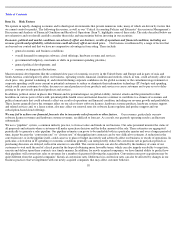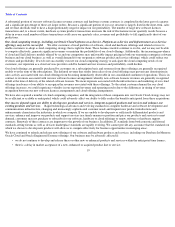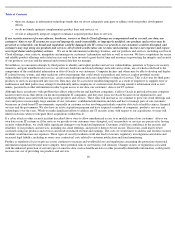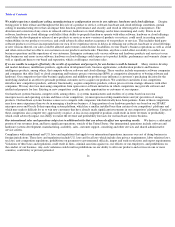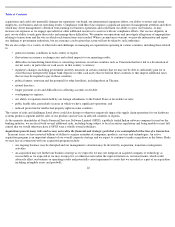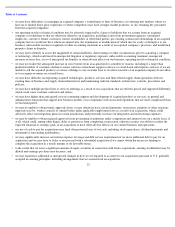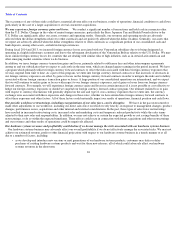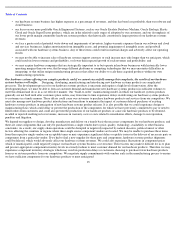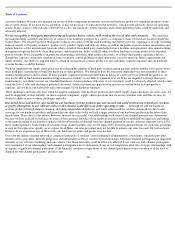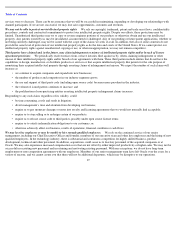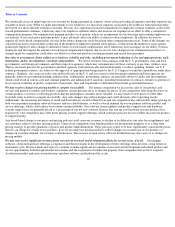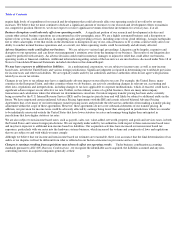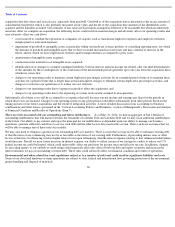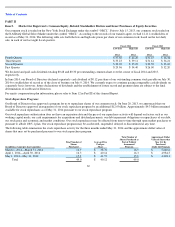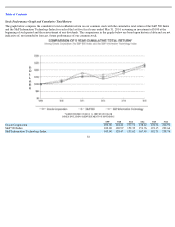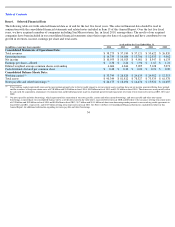Oracle 2013 Annual Report Download - page 30
Download and view the complete annual report
Please find page 30 of the 2013 Oracle annual report below. You can navigate through the pages in the report by either clicking on the pages listed below, or by using the keyword search tool below to find specific information within the annual report.
Table of Contents
customer demand. We must also manage our levels of older component inventories used in our hardware products to minimize inventory write-
offs or write-downs. If we have excess inventory, it may be necessary to write-down the inventory, which would adversely affect our operating
results. If one or more of the risks described above occurs, our hardware systems business and related operating results could be materially and
adversely affected.
We are susceptible to third party manufacturing and logistics delays, which could result in the loss of sales and customers. We outsource
the manufacturing, assembly and delivery of certain of our hardware products to a variety of companies, many of which are located outside the
United States. Our reliance on these third parties reduces our control over the manufacturing and delivery process, exposing us to risks, including
reduced control over quality assurance, product costs, product supply and delivery delays as well as the political and economic uncertainties and
natural disasters of the international locations where certain of these third party manufacturers have facilities and operations. Any manufacturing
disruption or logistics delays by these third parties could impair our ability to fulfill orders for these hardware systems products for extended
periods of time. If we are unable to manage our relationships with these third parties effectively, or if these third parties experience delays,
disruptions, capacity constraints, regulatory issues or quality control problems in their operations, or fail to meet our future requirements for
timely delivery, our ability to ship and deliver certain of our hardware systems products to our customers could be impaired and our hardware
systems business could be harmed.
We have simplified our supply chain processes by reducing the number of third party manufacturing partners and the number of locations where
these third party manufacturers build our hardware systems products. We therefore have become more dependent on a fewer number of these
manufacturing partners and locations. If these partners experience production problems or delays or cannot meet our demand for products, we
may not be able to find alternate manufacturing sources in a timely or cost effective manner, if at all. If we are required to change third party
manufacturers, our ability to meet our scheduled hardware systems products deliveries to our customers could be adversely affected, which could
cause the loss of sales and existing or potential customers, delayed revenue recognition or an increase in our hardware systems products
expenses, all of which could adversely affect the margins of our hardware business.
These challenges and risks also exist when we acquire companies with hardware products and related supply chain operations. In some cases, we
may be dependent, at least initially, on these acquired companies’ supply chain operations that we are less familiar with and thus we may be
slower to adjust or react to these challenges and risks.
Our mixed direct and indirect sales model for our hardware systems products may not succeed and could result in lower hardware revenues
or profits. Disruptions to our software indirect sales channel could affect our future operating results. Although we sell our hardware
systems products through indirect channels, including independent distributors and value added resellers, we have enhanced our direct sales
coverage for our hardware products and intend that our direct sales force will sell a larger portion of our hardware products in the future than
they do now. These direct sales efforts, however, may not be successful. Our relationships with some of our channel partners may deteriorate
because we have reduced our reliance on some of these partners for sales of our hardware products and have modified our approach and timing
to the manufacturing of our products, which could result in reduced demand from the channel partners or certain customer segments serviced by
these channel partners. Some hardware revenues from channel partners may not be replaced by revenues generated from our own sales personnel
or may not be replaced as quickly as we expect. In addition, our sales personnel may not be able to achieve our sales forecasts for our hardware
business. If we experience any of these risks, our hardware revenues and profits may decline.
Our software indirect channel network is comprised primarily of resellers, system integrators/implementers, consultants, education providers,
internet service providers, network integrators and independent software vendors. Our relationships with these channel participants are important
elements of our software marketing and sales efforts. Our financial results could be adversely affected if our contracts with channel participants
were terminated, if our relationships with channel participants were to deteriorate, if any of our competitors enter into strategic relationships with
or acquire a significant channel participant, if the financial condition or operations of our channel participants were to weaken or if the level of
demand for our channel participants’ products and
26




